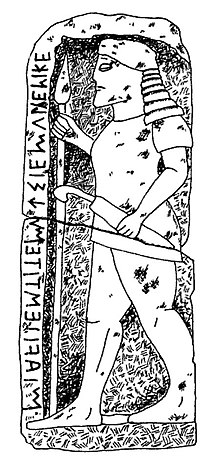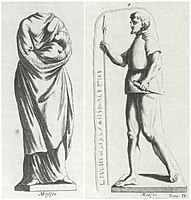Stele of Avile Tite
The stele of Avile Tite is an Etruscan tomb from the 6th century BC. The stele marked the burial place of a person named Avile Tite and is now in the Museo Etrusco Guarnacci of Volterra .
The stele
The limestone stele is 170 cm high, 70 cm wide and 30 cm thick. On the front of the stele an armed man is carved out of the limestone so that he stands out from the background as a relief . The massive figure is shown in profile with the face to the left. The legs are spread apart as if the man were walking forward. He wears an Ionic chiton and is armed with a lance and a dagger with a curved handle. The man wears a goatee and his shoulder-length hair is apparently braided into a pigtail at the back of his head . His eyes are almond-shaped and his mouth shows an archaic smile . Overall, the representation shows Ionic references, which can be traced back to the contact and exchange with Greek seafarers and traders. The stele is made between 550 and 525 BC. Dated.
Today it is assumed that the person is depicted without any other martial attributes such as breastplate or greaves , except for the lance and dagger . In this respect, the description of the sitter as a warrior is not entirely appropriate. Rather, the person is civilly dressed with arms as symbols of social status. The lance could be the attribute of an official dignitary. As a sacrificial instrument, the dagger is likely to have had a ceremonial character and could assign a religious function to the deceased.
The stele, which is made up of two roughly equal-sized fragments, has the shape of a cuboid with a curved top and a rounded lower left corner. The field with the figure was carved into the limestone so that a frame was created on the sides. An inscription is engraved on the left side of the frame, the upper side of the frame is asymmetrically arched, and the lower side of the frame is rounded only in the left corner. It can therefore be assumed that there was also a frame on the right side, which was removed after the stele was discovered. The frame has probably also been cut below. Perhaps the stele should be adapted to a transport or storage container.
The inscription
The inscription is in Etruscan letters in the archaic style of the 6th century BC. Written without separation of the individual words and is divided into two sections. In the first part the stele names its owner, in the second part the tomb gives its donor.
- MI AVILEŚ TITE [Ś] [...] UCHSIE MULENIKE
- I (am the property) of Avile Tite. (...) she donated (me).
The letter in the form of a mirror-inverted F, which is transcribed with V , was pronounced like a W. The letter M in the inscription corresponds to the Phoenician letter Sadéh or Zade and probably stands for a Sch sound. This letter, which is transcribed as Ś, was mainly used in northern Etruria. The letter ᗐ, which is transcribed as CH, probably stands for an aspirated K.
AVILEŚ TITEŚ is the genitive form of the deceased's name with Avile as the first name and Tite as the gentile name . The naming mode, in which the first name is supplemented by a name of the origin, emerged about a century earlier. UCHSIE could be the ending of a North Era gentile name. The founder would therefore not be related to the deceased. The reason to donate the tomb could then have resulted from a special obligation towards the deceased. A donation agreement between two leaders would be conceivable, through which a kind of succession has been sealed. But it also seems possible that UCHSIE is the ending of a first name. Then the founder, possibly a son, would have to come from the family of the deceased and the stele would be part of an aristocratic ancestor cult.
background
The stele was probably found around 1494 by the Italian humanist Raffaello Maffei (1451–1522) near Volterra (Etruscan Velathri ). He kept the stele together with an Etruscan marble statue of a woman and child ( Kourotrophos Maffei ) in his palace in Volterra. Maffei also made a copy of the inscription on the stele, which is one of the earliest copies of Etruscan texts. Unaware of the Etruscan letters and writing habits, Maffei copied the inscription upside down and mostly with the wrong characters. The beginning of his copy can be clearly assigned to the inscription on the stele.
However, the text on the copy by Raffaello Maffei is longer than the one on the stele. Hence, one might consider that the missing part came from the severed right frame. This is contradicted by the fact that most Etruscan inscriptions on steles and votive offerings end with the formulaic MULUVENIKE or MULENIKE. In addition, the recently awakened interest in Etruscan writing would not have made it possible to cut off an inscribed part of the monument in order to adapt it to a container. Rather, Maffei seems to reproduce two inscriptions in his copy. The first part comes from the stele of Avile Tite and the second from the marble statue of the Etruscan woman with an inscription on her arm. The incorrect reproduction of the characters ultimately prevents a clear assignment.
Raffaello Maffei did not specify the place where the stele was found in his writings. It is assumed that it was found at the necropolis outside the city in front of the Porta a Selci or the Porta all'Arco. The Portone necropolis north of Volterra is also worth considering. The tomb could have been in front of a burial chamber or in front of the burial mound of an important family with a multi-chamber grave . In this respect, the social status of the deceased is also unclear. Avile Tite could have been the ancestor of an aristocratic gens . It is also conceivable that Avile Tite was a high dignitary in the popular assembly ( comitia ), which, like the Romans , probably consisted of individual departments ( curia ). At these meetings each curia was represented by a minister. The main focus in the meetings was probably on the sacred area. Perhaps Avile Tite was the official representative of such a curia.
Individual evidence
- ↑ Testimonia Linguae Etruscae TLE 2 386.
- ^ Raffaele Maffei: Commentariorum urbanorum octo et triginta libri. Rome 1506, folio 463.
See also
- Etruscan language
- Etruscan script
- Etruscan naming
- List of Etruscan words
- Stele of Avele Feluske
- Stele of Larth Ninie
literature
- Giuliano Bonfante , Larissa Bonfante : The Etruscan Language. An Introduction. 2nd Edition. Manchester University Press, Manchester / New York 2002, ISBN 0719055407 , pp. 22-23, 141-142.
- Sybille Haynes : Etruscan Civilization: A Cultural History. Getty Publications, Los Angeles 2000, ISBN 0892366001 , pp. 249-250.
- Françoise-Hélène Massa-Pairault: La stele di "Avile Tite" by Raffaele il Volterrano ai giorni nostri. In: Mélanges de l'école française de Rome. Volume 103, No. 2, 1991, pp. 499-528. ( online )





